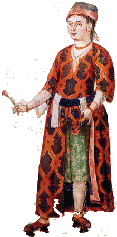 During Ottoman times, a great distinction was made between the garments that women wore indoors and outdoors. Around the beginning of the 16th century, women's outdoor clothing consisted of ferace (overmantle), yaşmak (light-colored veil), and peçe (black veil). Winter overmantles were made of wool while those worn in summer were of silk. They had full sleeves and wrapped the body very loosely. Opening in the front, their lengths reached the ground. During the 18th century, trimmed collars were added to the overmantle. Over the years, the lengths of the "collars" varied, sometimes reaching as far as the lower hem as during the reign of Mahmud 11. During the second half of the 19th century skirt fronts were cut round and were fastened with a single button. Edges were embellished with pleating. Overmantle colors played an important role during Ottoman times: Muslim women wore red, blue, or green feraces while those worn by non-Muslim women were of paler shades.
During Ottoman times, a great distinction was made between the garments that women wore indoors and outdoors. Around the beginning of the 16th century, women's outdoor clothing consisted of ferace (overmantle), yaşmak (light-colored veil), and peçe (black veil). Winter overmantles were made of wool while those worn in summer were of silk. They had full sleeves and wrapped the body very loosely. Opening in the front, their lengths reached the ground. During the 18th century, trimmed collars were added to the overmantle. Over the years, the lengths of the "collars" varied, sometimes reaching as far as the lower hem as during the reign of Mahmud 11. During the second half of the 19th century skirt fronts were cut round and were fastened with a single button. Edges were embellished with pleating. Overmantle colors played an important role during Ottoman times: Muslim women wore red, blue, or green feraces while those worn by non-Muslim women were of paler shades.
Yaşmaks were made from a fine, soft, white fabric and consisted of two parts: one that was wrapped about the head covering it to the eyebrows and another that covered the lower part of the face to just the bridge of the nose.
 The çarşaf, a baggy outer garment, is a fairly late addition to the Ottoman woman's wardrobe, having been introduced from Syria after 1872. Made from two long pieces of cloth joined together and fastened in pleats at the waist with a drawstring, it was worn together with a transparent veil over the face. This innovation did not always meet with approval; Sultan Abdiilhamid 11 for example expressly forbade the women of his palace to wear it. The baggy Çarşaf was in some cases replaced by a two-piece affair consisting of a skirt and cape.
The çarşaf, a baggy outer garment, is a fairly late addition to the Ottoman woman's wardrobe, having been introduced from Syria after 1872. Made from two long pieces of cloth joined together and fastened in pleats at the waist with a drawstring, it was worn together with a transparent veil over the face. This innovation did not always meet with approval; Sultan Abdiilhamid 11 for example expressly forbade the women of his palace to wear it. The baggy Çarşaf was in some cases replaced by a two-piece affair consisting of a skirt and cape.
Within the home, Ottoman women of the 16th and 17th centuries dressed in ankle-length trousers called şalvar, long-sleeved shifts of a seersucker gauze that reached down to the heels, long-sleeved cardigans, and robes known as kaftan. Open in the front and lacking any trimming, the fullness of the skirts of these robes was increased by the addition of narrow godets from the waist down. This style is common in skirts until the 19th century.
 The dresses called üçetek (having a three-panelled skirt) and dörtetek (having a four-panelled skirt) make their appearance in the early 19th century. Another costume consisting of baggy shalwars, a short, tight~fitting jacket embroidered with silver thread, and a sash with embroidered ends bound at the waist was as elegant as it was comfortable to wear. Blouses were made of seersucker or silk and had cuffs and collars trimmed with lace. A type of dress called bindalli made from velvet or satin and heavily embroidered with elaborate patterns in silver and gold braid were indispensable attire for special occasions such as bridal henna-parties.
The dresses called üçetek (having a three-panelled skirt) and dörtetek (having a four-panelled skirt) make their appearance in the early 19th century. Another costume consisting of baggy shalwars, a short, tight~fitting jacket embroidered with silver thread, and a sash with embroidered ends bound at the waist was as elegant as it was comfortable to wear. Blouses were made of seersucker or silk and had cuffs and collars trimmed with lace. A type of dress called bindalli made from velvet or satin and heavily embroidered with elaborate patterns in silver and gold braid were indispensable attire for special occasions such as bridal henna-parties.
 One result of steadily increasing European influence on the Ottoman Empire was the occasional use of imported European fabrics in the making of traditional woman's garments beginning in the 18th century. During the 19th century, such traditional garments as the üçetek and shalwar are cast aside in favor of costumes influenced by Parisian fashions. Traditional dresses are replaced by close-fitting corseted garments, blouses with long, full sleeves, and long, flounced skirts. Such attire was naturally accompanied by accessories such as silk stockings, fans, gloves, and parasols. The most important garment in any woman's life is her wedding-dress. During every period,
One result of steadily increasing European influence on the Ottoman Empire was the occasional use of imported European fabrics in the making of traditional woman's garments beginning in the 18th century. During the 19th century, such traditional garments as the üçetek and shalwar are cast aside in favor of costumes influenced by Parisian fashions. Traditional dresses are replaced by close-fitting corseted garments, blouses with long, full sleeves, and long, flounced skirts. Such attire was naturally accompanied by accessories such as silk stockings, fans, gloves, and parasols. The most important garment in any woman's life is her wedding-dress. During every period,  wedding-dresses have been made using the most expensive fabrics available according to the prevailing fashion and style. Until fairly late in the 19th century, Ottoman brides dressed in lively colors (red was a particular favorite) at their weddings. The bridal veil was also made of red gauze well into the 19th century and was embroidered with silver and gold braid. European fashions however begin to weigh heavily in the design of Ottoman bridal costumes from about the 1870's onward. While the fabrics are silk, the colors tend to be pastel pinks, blues, and creams. The gowns are made in two parts and have a train while the traditional silver and gold braid embellishments are augmented with lace, pearls, and sequins. During this period, bridal gowns were sometimes worn beneath a matching fur-lined kaftan.In 1898, Princess Naime, daughter of Abdülhamid II, wore a pure-white bridal gown at her wedding. The fashion of the bride's wearing white thus introduced by the court was to influence the rest of Turkish society in the following century.
wedding-dresses have been made using the most expensive fabrics available according to the prevailing fashion and style. Until fairly late in the 19th century, Ottoman brides dressed in lively colors (red was a particular favorite) at their weddings. The bridal veil was also made of red gauze well into the 19th century and was embroidered with silver and gold braid. European fashions however begin to weigh heavily in the design of Ottoman bridal costumes from about the 1870's onward. While the fabrics are silk, the colors tend to be pastel pinks, blues, and creams. The gowns are made in two parts and have a train while the traditional silver and gold braid embellishments are augmented with lace, pearls, and sequins. During this period, bridal gowns were sometimes worn beneath a matching fur-lined kaftan.In 1898, Princess Naime, daughter of Abdülhamid II, wore a pure-white bridal gown at her wedding. The fashion of the bride's wearing white thus introduced by the court was to influence the rest of Turkish society in the following century.

Hiç yorum yok:
Yorum Gönder